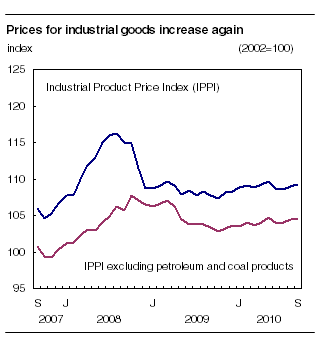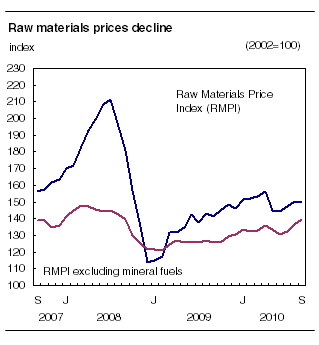Common menu bar links
Industrial product and raw materials price indexes
Archived Content
Information identified as archived is provided for reference, research or recordkeeping purposes. It is not subject to the Government of Canada Web Standards and has not been altered or updated since it was archived. Please "contact us" to request a format other than those available.
Related subjects
The Industrial Product Price Index (IPPI) increased 0.2% in September compared with August, led mainly by primary metal products. The Raw Materials Price Index declined 0.4% in September, largely because of significantly lower prices for mineral fuels.

The IPPI rose 0.2% in September, following a 0.4% increase in August. The index continued an upward trend that began in November 2009, although during this period, the IPPI increased a moderate 0.9%.
In September, the IPPI gain was mainly led by primary metal products (+2.0%) and, to a lesser extent, by petroleum and coal products (+0.5%). The increase in prices of primary metal products was mainly attributable to strong demand for precious metals. In addition, over the past several months, non-precious metals have faced reduced production as well as lower inventories.
The 0.5% decrease in prices for motor vehicles and other transportation equipment moderated the IPPI advance. This decline was largely due to a 0.8% increase in the value of the Canadian dollar relative to the US dollar.
Some Canadian producers who export their products to the United States are generally paid on the basis of prices set in US dollars. Consequently, the strength of the Canadian dollar in relation to the US dollar had the effect of reducing the corresponding prices in Canadian dollars.
Conversion of indexes to 2002=100
With the release of August 2010 data, the Producer Prices Division converted the Industrial Product Price Index (IPPI) and the Raw Materials Price Index (RMPI) series to 2002=100, with 2002 as the base year. These indexes have also been updated using a 2002 weighting pattern based on the production values of 2002.
All data in this release are seasonally unadjusted and are subject to revision for six months (for example, when the July index is released, the index for the preceding January becomes final).
The IPPI reflects the prices that producers in Canada receive as the goods leave the plant gate. It does not reflect what the consumer pays. Unlike the Consumer Price Index, the IPPI excludes indirect taxes and all the costs that occur between the time a good leaves the plant and the time the final user takes possession of it, including the transportation, wholesale, and retail costs.
The conversion of prices received in US dollars is based on the average monthly exchange rate (noon spot rate) established by the Bank of Canada, and it is available on CANSIM in table 176-0064 (series v37426). Monthly and annual variations in the exchange rate, as described in the release, are calculated according to the indirect quotation of the exchange rate (for example, CAN$1=US$X).
The RMPI reflects the prices paid by Canadian manufacturers for key raw materials. Many of those prices are set on the world market. However, as few prices are denominated in foreign currencies, their conversion into Canadian dollars has only a minor effect on the calculation of the RMPI.
Excluding petroleum and coal prices, the IPPI would have increased for a third consecutive month, advancing 0.1% in September following gains of 0.4% in August and 0.1% in July.
12-month change in the IPPI: Rising trend continues
The IPPI was up 1.4% in September compared with the same month a year earlier, following a 0.6% increase in August. The gain in September was the second largest since January 2010.
In the previous 12 months, the IPPI advance was mainly a result of higher prices for primary metal products (+9.0%) and, to a lesser extent, petroleum and coal products (+4.2%), chemical products (+3.5%), pulp and paper products (+3.1%) as well as rubber, leather and plastic fabricated products (+3.1%).
The 4.7% appreciation of the Canadian dollar relative to the US dollar dampened the IPPI year-over-year gain in September.
Prices for motor vehicles and other transportation equipment, which are particularly sensitive to the exchange rate, fell 2.4% in September, continuing their downward movement that started in October 2009.
Year-over-year, the IPPI excluding petroleum and coal increased 1.2% in September, following a 0.7% advance in August. It was the fifth consecutive year-over-year increase.
Raw Materials Price Index: Downturn of the monthly movement
The Raw Materials Price Index (RMPI) declined 0.4% in September, led by lower prices for mineral fuels (-3.3%), particularly for crude oil (-3.7%).
In September, higher prices for non-ferrous metals (+4.0%) and vegetable products (+5.5%) moderated the impact that the decline in mineral fuels had on the RMPI.
Excluding mineral fuels, the RMPI increased 2.2% in September following a 2.9% advance in August. The movement of the index indicates a reinforcement of the upward trend, and the index has returned to the same level as in September 2008.
Compared with the same month a year earlier, the RMPI rose 5.8% in September, following a 5.0% advance in August. Year-over-year, the RMPI has been on an upward trend since November 2009. Prices of non-ferrous metals (+14.1%), animal and animal products (+9.1%), vegetable products (+16.5%) and ferrous materials (+21.3%) were the main contributors to the RMPI year-over-year increase in September.
Excluding mineral fuels, the RMPI was up 10.6% compared with September 2009. This was the strongest advance of the past 12 year-over-year movements.

Available on CANSIM: tables 329-0056 to 329-0068 and 330-0007.
Tables 329-0056: Industrial Product Price Index by major commodity aggregations.
Table 329-0057: Industrial Product Price Index by industry.
Table 329-0058: Industrial Product Price Index by stage of processing.
Tables 329-0059 to 329-0068: Industrial Product Price Index by commodity.
Table 330-0007: Raw Materials Price Index by commodity.
Definitions, data sources and methods: survey numbers, including related surveys, 2306 and 2318.
The September 2010 issue of Industry Price Indexes (62-011-X, free) will soon be available.
The industrial product and raw material price indexes for October will be released on November 29.
For more information, or to enquire about the concepts, methods or data quality of this release, contact Client Services (toll-free 1-888-951-4550; 613-951-4550; fax: 613-951-3117; ppd-info-dpp@statcan.gc.ca), Producer Prices Division.
Table 1
| Relative importance1 | September 2009 | August 2010r | September 2010p | August to September 2010 | September 2009 to September 2010 | |
|---|---|---|---|---|---|---|
| (2002=100) | % change | |||||
| Industrial Product Price Index (IPPI) | 100.00 | 107.7 | 109.0 | 109.2 | 0.2 | 1.4 |
| IPPI excluding petroleum and coal products | 93.70 | 103.3 | 104.4 | 104.5 | 0.1 | 1.2 |
| Aggregation by commodities | ||||||
| Meat, fish and dairy products | 6.08 | 103.8 | 105.0 | 104.9 | -0.1 | 1.1 |
| Fruit, vegetable, feeds and other food products | 5.52 | 117.9 | 117.4 | 117.7 | 0.3 | -0.2 |
| Beverages | 1.52 | 117.2 | 118.9 | 118.7 | -0.2 | 1.3 |
| Tobacco and tobacco products | 0.56 | 161.6 | 162.7 | 162.7 | 0.0 | 0.7 |
| Rubber, leather and plastic fabricated products | 3.51 | 113.7 | 117.2 | 117.2 | 0.0 | 3.1 |
| Textile products | 1.37 | 101.3 | 101.4 | 101.4 | 0.0 | 0.1 |
| Knitted products and clothing | 1.33 | 101.2 | 100.7 | 100.7 | 0.0 | -0.5 |
| Lumber and other wood products | 6.04 | 88.7 | 89.5 | 89.6 | 0.1 | 1.0 |
| Furniture and fixtures | 2.19 | 116.8 | 116.5 | 116.5 | 0.0 | -0.3 |
| Pulp and paper products | 6.40 | 99.2 | 102.6 | 102.3 | -0.3 | 3.1 |
| Printing and publishing | 1.84 | 104.0 | 103.4 | 103.2 | -0.2 | -0.8 |
| Primary metal products | 6.99 | 132.1 | 141.2 | 144.0 | 2.0 | 9.0 |
| Fabricated metal products | 4.45 | 121.2 | 121.9 | 122.2 | 0.2 | 0.8 |
| Machinery and equipment | 4.41 | 104.6 | 103.5 | 103.4 | -0.1 | -1.1 |
| Motor vehicles and other transport equipment | 24.34 | 80.3 | 78.8 | 78.4 | -0.5 | -2.4 |
| Electrical and communications products | 5.02 | 95.8 | 94.1 | 93.9 | -0.2 | -2.0 |
| Non-metallic mineral products | 2.07 | 117.0 | 117.1 | 117.5 | 0.3 | 0.4 |
| Petroleum and coal products | 6.30 | 173.1 | 179.5 | 180.4 | 0.5 | 4.2 |
| Chemicals and chemical products | 7.19 | 121.8 | 125.9 | 126.1 | 0.2 | 3.5 |
| Miscellaneous manufactured products | 2.60 | 112.8 | 115.6 | 116.0 | 0.3 | 2.8 |
| Miscellaneous non-manufactured products | 0.30 | 256.1 | 243.7 | 253.4 | 4.0 | -1.1 |
| Intermediate goods2 | 62.15 | 113.7 | 116.1 | 116.5 | 0.3 | 2.5 |
| First-stage intermediate goods3 | 7.56 | 127.2 | 136.5 | 138.2 | 1.2 | 8.6 |
| Second-stage intermediate goods4 | 54.60 | 111.8 | 113.3 | 113.6 | 0.3 | 1.6 |
| Finished goods5 | 37.85 | 97.9 | 97.4 | 97.3 | -0.1 | -0.6 |
| Finished foods and feeds | 7.12 | 112.8 | 114.2 | 114.2 | 0.0 | 1.2 |
| Capital equipment | 12.19 | 89.4 | 87.7 | 87.5 | -0.2 | -2.1 |
| All other finished goods | 18.54 | 97.6 | 97.4 | 97.2 | -0.2 | -0.4 |
Table 2
| Relative importance1 | September 2009 | August 2010r | September 2010p | August to September 2010 | September 2009 to September 2010 | |
|---|---|---|---|---|---|---|
| (2002=100) | % change | |||||
| Raw Materials Price Index (RMPI) | 100.00 | 141.5 | 150.3 | 149.7 | -0.4 | 5.8 |
| RMPI excluding mineral fuels | 58.56 | 126.0 | 136.4 | 139.4 | 2.2 | 10.6 |
| Mineral fuels | 41.44 | 163.7 | 170.1 | 164.5 | -3.3 | 0.5 |
| Vegetable products | 9.89 | 108.3 | 119.6 | 126.2 | 5.5 | 16.5 |
| Animal and animal products | 19.81 | 101.6 | 111.0 | 110.8 | -0.2 | 9.1 |
| Wood | 11.82 | 89.6 | 88.8 | 88.7 | -0.1 | -1.0 |
| Ferrous materials | 2.88 | 139.7 | 167.1 | 169.4 | 1.4 | 21.3 |
| Non-ferrous metals | 11.32 | 213.9 | 234.6 | 244.0 | 4.0 | 14.1 |
| Non-metallic minerals | 2.82 | 143.6 | 147.2 | 147.2 | 0.0 | 2.5 |

